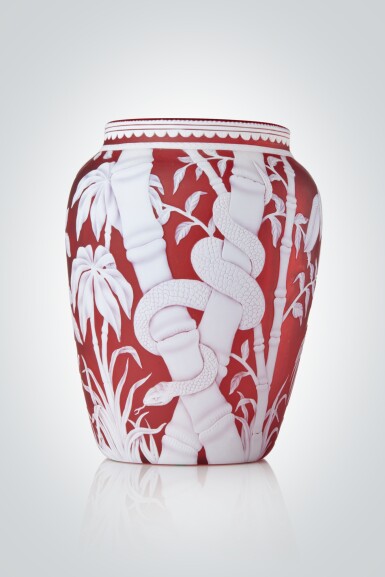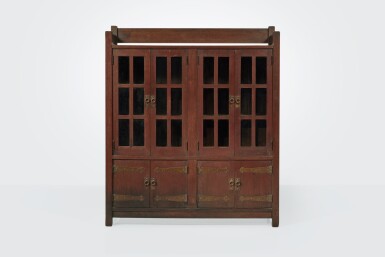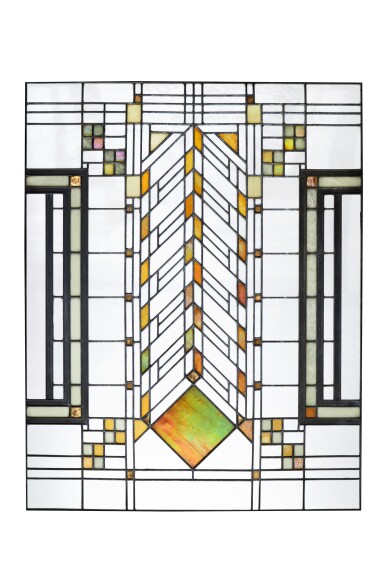Jean RoyèreUnique Bookcase
circa 1936oak, glass, brass85½ x 78 x 30¼ in. (217.2 x 198.1 x 76.8 cm)Condition reportOverall in very good condition. This unique bookcase was custom built for a specific commission and requires installation. The wooden surfaces appear to have been sensitively refinished at some point in the history of the piece to revitalize the rich quality of the oak, and presents with areas of restoration and inpainting. The wood overall with light surface scratches, minute losses, abrasions and indentations concentrated to the edges and appropriate with age and gentle use. The end of one shelf with a hairline crack measuring approximately 10 1/4 in. long with evidence of prior restoration. The top of one shelf with three more pronounced scratches, the largest measuring approximately 12 in. long and not visually distracting. The glass elements with very minor surface soiling, scratches and abrasions, concentrated to the edges and consistent with age and gentle use. The surface of one glass panel with a slightly more pronounced scratch measuring approximately 7 in. long and not visually distracting. The edge of one glass panel presents with a rougher texture, possibly inherent to the making and not visually distracting. The side of the lower cabinet presents with one slightly more pronounced line of indentation, measuring approximately 5 in. long. The top edge of the horizontal wooden section below the sliding doors with a more pronounced concentration of abrasion and losses to the wood. The sliding doors with areas of discoloration to the wood, not visually distracting. The brass elements with light surface scratches, abrasions, and edge indentations with soiling concentrated the recessed areas, typical with age and gentle use.ProvenanceAcquired directly from the designer, 1936
Thence by descent
Acquired from the above by the present ownerLiteraturePierre-Emmanuel Martin-Vivier, Jean Royère Paris, 2002, p. 54 (for a period photograph of the bookcase)
Galerie Jacques Lacoste and Galerie Patrick Seguin, Jean Royère : Volume 2, Paris, 2012, p. 75 (for a related model)
Pierre-Emmanuel Martin-Vivier, Jean Royère Paris, 2017, p. 64 (for the above mentioned period photograph of the bookcase)Catalogue noteThe present bookcase was part of an interior design project of leading French designer Jean Royère dating from the early stages of his prolific career which spanned over four decades. Being drawn to design later in life, Royère gained fabrication and material intelligence while working in cabinet-making workshops in Paris beginning in 1931. Throughout the 1930’s, Royère gained independent work for a clientele of the upper-middle class. These clients were living in modestly sized apartments, often without house staff. Royère was thus employed to focus on spatial planning where he favored simple, cohesive interiors with furniture pieces designed around specific functions. Influenced by other contemporary modernists such as Robert Mallet-Stevens and Djo-Bourgeois, Royère utilized metal and incorporated large plinths or planes of solid materials which, in addition to being visually pleasing, were easier to clean and maintain. He incorporated dramatic lighting and playful materials, often sourcing bright, geometric fabrics from Élise Djo-Bourgeois.
The era of functionalism for Royère served more as a pretext to his later, more ornamental and decorative period than it was a lifelong ethical dedication as it was for many other modernists of the period. The rejection of ornamentation led Royère to study form and function and to learn about both traditional and innovative materials. The first glimpse into what would become his celebrated style of refined fantasy was a sideboard he presented in 1937 at the Paris International exhibition. It was decorated with shells and painted with fish in cellulose lacquer. He presented other furniture that broke with pure functionalism - utilizing bright colors, bold tones and creative materials such as fur and rattan. Royère’s understanding of material and form came to an apex with icon designs such as the “Ours Polaire” sofas and chairs (circa 1950) and the “Ondulation” series of furniture and lights (1950s).
In 1936 Royère designed a study in an apartment on the exclusive quai de Bourbon in Paris - a quintessential project from the first few years of his career. Royère designed the small room with a shelving unit on either side, a chair and freestanding desk in the center and curtains made from striped fabric by Elise Djo-Bourgeois. In a truly modern design language, the furnishings were angular and modular. The desk was made from intersecting planes with the top cantilevering to one side. The chair utilized bent metal tubing, a new and innovative material at this time. The present bookshelf was one of the custom made, built-in units from this apartment. It has countertops and shelves made from thick, horizontal slabs of oak and rectangular pieces of glass placed vertically to act as structural elements. The lower section comprises cabinets that have sliding doors inset with simple, round metal handles. The present bookshelf exhibits the modernist qualities indicative of the early career of Jean Royère and is a precursor to the designer’s highly sought after designs of the postwar period.Catalogue note
Jean RoyèreUnique Bookcase
circa 1936oak, glass, brass85½ x 78 x 30¼ in. (217.2 x 198.1 x 76.8 cm)Condition reportOverall in very good condition. This unique bookcase was custom built for a specific commission and requires installation. The wooden surfaces appear to have been sensitively refinished at some point in the history of the piece to revitalize the rich quality of the oak, and presents with areas of restoration and inpainting. The wood overall with light surface scratches, minute losses, abrasions and indentations concentrated to the edges and appropriate with age and gentle use. The end of one shelf with a hairline crack measuring approximately 10 1/4 in. long with evidence of prior restoration. The top of one shelf with three more pronounced scratches, the largest measuring approximately 12 in. long and not visually distracting. The glass elements with very minor surface soiling, scratches and abrasions, concentrated to the edges and consistent with age and gentle use. The surface of one glass panel with a slightly more pronounced scratch measuring approximately 7 in. long and not visually distracting. The edge of one glass panel presents with a rougher texture, possibly inherent to the making and not visually distracting. The side of the lower cabinet presents with one slightly more pronounced line of indentation, measuring approximately 5 in. long. The top edge of the horizontal wooden section below the sliding doors with a more pronounced concentration of abrasion and losses to the wood. The sliding doors with areas of discoloration to the wood, not visually distracting. The brass elements with light surface scratches, abrasions, and edge indentations with soiling concentrated the recessed areas, typical with age and gentle use.ProvenanceAcquired directly from the designer, 1936
Thence by descent
Acquired from the above by the present ownerLiteraturePierre-Emmanuel Martin-Vivier, Jean Royère Paris, 2002, p. 54 (for a period photograph of the bookcase)
Galerie Jacques Lacoste and Galerie Patrick Seguin, Jean Royère : Volume 2, Paris, 2012, p. 75 (for a related model)
Pierre-Emmanuel Martin-Vivier, Jean Royère Paris, 2017, p. 64 (for the above mentioned period photograph of the bookcase)Catalogue noteThe present bookcase was part of an interior design project of leading French designer Jean Royère dating from the early stages of his prolific career which spanned over four decades. Being drawn to design later in life, Royère gained fabrication and material intelligence while working in cabinet-making workshops in Paris beginning in 1931. Throughout the 1930’s, Royère gained independent work for a clientele of the upper-middle class. These clients were living in modestly sized apartments, often without house staff. Royère was thus employed to focus on spatial planning where he favored simple, cohesive interiors with furniture pieces designed around specific functions. Influenced by other contemporary modernists such as Robert Mallet-Stevens and Djo-Bourgeois, Royère utilized metal and incorporated large plinths or planes of solid materials which, in addition to being visually pleasing, were easier to clean and maintain. He incorporated dramatic lighting and playful materials, often sourcing bright, geometric fabrics from Élise Djo-Bourgeois.
The era of functionalism for Royère served more as a pretext to his later, more ornamental and decorative period than it was a lifelong ethical dedication as it was for many other modernists of the period. The rejection of ornamentation led Royère to study form and function and to learn about both traditional and innovative materials. The first glimpse into what would become his celebrated style of refined fantasy was a sideboard he presented in 1937 at the Paris International exhibition. It was decorated with shells and painted with fish in cellulose lacquer. He presented other furniture that broke with pure functionalism - utilizing bright colors, bold tones and creative materials such as fur and rattan. Royère’s understanding of material and form came to an apex with icon designs such as the “Ours Polaire” sofas and chairs (circa 1950) and the “Ondulation” series of furniture and lights (1950s).
In 1936 Royère designed a study in an apartment on the exclusive quai de Bourbon in Paris - a quintessential project from the first few years of his career. Royère designed the small room with a shelving unit on either side, a chair and freestanding desk in the center and curtains made from striped fabric by Elise Djo-Bourgeois. In a truly modern design language, the furnishings were angular and modular. The desk was made from intersecting planes with the top cantilevering to one side. The chair utilized bent metal tubing, a new and innovative material at this time. The present bookshelf was one of the custom made, built-in units from this apartment. It has countertops and shelves made from thick, horizontal slabs of oak and rectangular pieces of glass placed vertically to act as structural elements. The lower section comprises cabinets that have sliding doors inset with simple, round metal handles. The present bookshelf exhibits the modernist qualities indicative of the early career of Jean Royère and is a precursor to the designer’s highly sought after designs of the postwar period.Catalogue note















Testen Sie LotSearch und seine Premium-Features 7 Tage - ohne Kosten!
Lassen Sie sich automatisch über neue Objekte in kommenden Auktionen benachrichtigen.
Suchauftrag anlegen